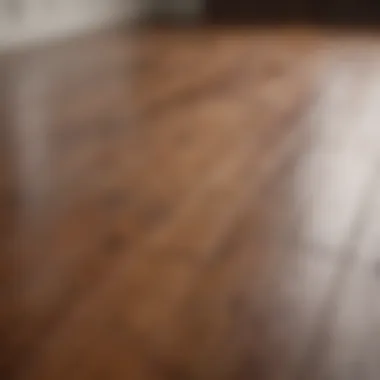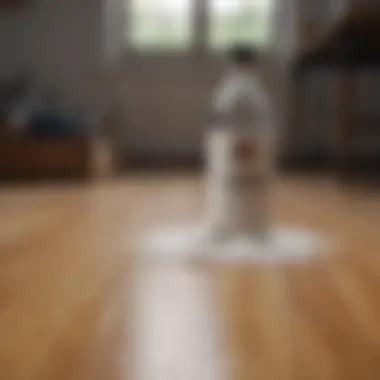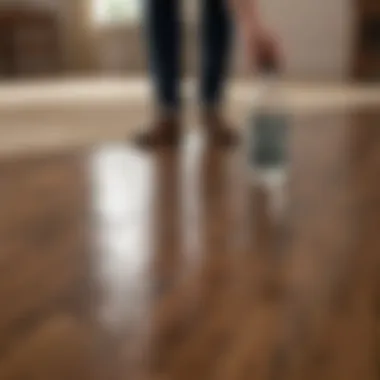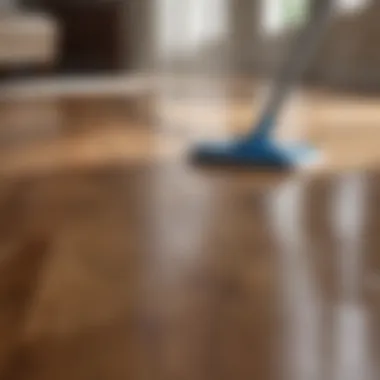Cleaning Hardwood Floors with White Vinegar: A Comprehensive Guide


Intro
Hardwood floors are a cherished feature in many homes, known for their elegance and timeless appeal. However, maintaining their beauty can sometimes be a challenge. One natural and economically feasible solution that has gained popularity is white vinegar. It is crucial to understand how to use this effective cleaning agent without damaging the wood's finish. This article will explore the properties of white vinegar, its effectiveness on hardwood floors, and best practices for maintaining this flooring material.
In your cleaning routine, the goal is to eliminate dirt and grime while preserving the integrity of the wood. Many homeowners seek alternatives to commercial cleaners that often contain harsh chemicals. The simple ingredients found in white vinegar offer a safer approach. This guide aims to equip you with the knowledge to clean your hardwood floors effectively, minimizing any adverse effects on their finishes while extending their longevity.
Key point to consider is that while vinegar is generally safe for hardwood floors, incorrect use can leave undesired results. For instance, excessive moisture can harm the wood, leading to warping. Understanding how to apply vinegar safely will be a focal point of this discussion.
In addition, this article will touch upon alternative cleaning methods, facts about floor maintenance, and tips to keep your hardwood floors looking their best.
"The beauty of hardwood floors lies in their natural charm; proper maintenance can enhance this appeal for years to come."
By the end of this guide, you should feel confident navigating the dos and don’ts of cleaning hardwood floors with white vinegar, ensuring your investment remains pristine.
Prelims to Hardwood Floor Maintenance
Hardwood floors are a valued component of many homes due to their aesthetic appeal and durability. Yet, maintaining these surfaces is essential to maximize their lifespan and beauty. In this article, we will focus on various strategies to clean hardwood floors effectively using white vinegar, a common yet powerful cleaning agent.
Importance of Proper Cleaning
Consistent care and maintenance of hardwood floors directly influence their condition. Proper cleaning helps to remove grime, dirt, and allergens that accumulate over time. This is vital not only for the appearance of the floors but also for the health of the household. A clean environment contributes to improved indoor air quality. Moreover, effective cleaning can prevent the buildup of substances that might scratch or damage the finish of the wood.
In choosing a cleaning method, it is crucial to consider materials that are safe for the floor’s finish. Many homeowners overlook the potential long-term impact of their cleaning habits, which can lead to costly repairs or refinishing. This article will address how white vinegar can serve as an effective cleaning agent while also discussing the necessary precautions needed to ensure the wood's integrity remains intact.
Challenges in Cleaning Hardwood Floors
Cleaning hardwood floors poses unique challenges that homeowners must navigate. One primary concern is the selection of appropriate cleaning solutions. Many traditional cleaners can be harsh, possibly leading to discoloration or damage over time. Homemade solutions like vinegar might seem safer, but their compatibility with various finishes requires careful consideration.
Additionally, the physical act of cleaning can also become a challenge. Excess moisture is often an enemy of hardwood. Using too much water or employing methods that leave floors wet can warp or soften wood fibers. Homeowners must learn techniques that keep floors not only clean but also dry. Understanding these challenges is crucial for anyone looking to maintain their hardwood floors effectively.
"Proper maintenance extends the life of hardwood floors, preserving their appearance and value."
White Vinegar as a Cleaning Agent
White vinegar serves as an effective cleaning agent, especially for hardwood floors. Its simple composition and low cost make it a popular choice among homeowners. The importance of this section is to highlight the specific elements, benefits, and considerations surrounding the use of white vinegar for cleaning. Understanding its chemical makeup, along with the benefits it brings, can aid homeowners in making informed decisions about floor care.
Chemical Composition of White Vinegar
White vinegar primarily consists of acetic acid, which typically makes up about 5-20% of its volume, diluted in water. This simple structure gives white vinegar its distinctive cleaning properties. The acetic acid is effective in breaking down dirt and grime, making it suitable for everyday cleaning tasks. Moreover, it does not contain synthetic additives or harmful chemicals, which is a significant advantage when cleaning areas frequented by children and pets. Using a natural product aligns with environmentally friendly cleaning practices, appealing to many homeowners.
Benefits of Using White Vinegar
Natural Disinfectant
The ability of white vinegar to act as a natural disinfectant is noteworthy. The acetic acid in vinegar can kill some types of bacteria and viruses, providing a level of sanitation that is crucial for maintaining a clean home. This aspect is particularly beneficial for surfaces that see a lot of foot traffic, like hardwood floors. Homeowners appreciate a solution that is effective without harsh chemicals, making white vinegar a popular choice.
Stain Removal Properties
In addition to disinfecting, white vinegar is effective in removing various stains. Its acidic nature allows it to penetrate the surface of the wood and lift stains that might otherwise be entrenched. Common stains from food spills or pet accidents can often be addressed with a simple vinegar solution. This characteristic makes it practical for households with children and pets, where accidents are more likely to occur.
Deodorizing Effect


Another valuable benefit of white vinegar is its deodorizing effect. It neutralizes odors in addition to cleaning, which can enhance the overall atmosphere in a home. This is especially useful in rooms where pets might spend a lot of time or areas that may retain smells from cooking or food storage. Homeowners can rely on white vinegar to leave their floors clean and fresh without the need for synthetic fragrances, which can sometimes pose allergy concerns.
White vinegar offers a range of benefits, from disinfection to deodorization, making it an ideal choice for cleaning hardwood floors.
Assessing the Suitability of Vinegar for Your Floors
When considering cleaning hardwood floors, evaluating the suitability of white vinegar is an essential step. Not all wood floors are created equal, and various finishes can significantly affect how vinegar interacts with the surface. Understanding these differences helps prevent damage and maintains the beauty of your flooring.
Understanding Wood Finishes
Waxed vs. Unwaxed Surfaces
Waxed surfaces usually have a protective coating of wax that can enhance the wood’s natural look. However, this finish can be sensitive to vinegar. Using vinegar on waxed floors may strip the wax, leading to dullness and increased susceptibility to scratches. On the other hand, unwaxed surfaces do not have this protective layer, making them more compatible with vinegar. The key characteristic here is that while unwaxed surfaces might be easier to clean with vinegar, they may also show more wear over time. The choice between the two has its own advantages and drawbacks. In this context, it’s important to think about how often your floors need cleaning and what type of finish has been applied.
Types of Finishes: Oil, Water-Based, and Polyurethane
Different finishes play a significant role in determining how vinegar will affect your hardwood floors. Oil finishes penetrate the wood, offering deep protection, but can react adversely with acidic substances like vinegar. Water-based finishes dry quickly and are generally more resistant to water; however, they can also degrade with acidic cleaners. Polyurethane finishes provide excellent durability and resistance to stains, which results in them being more tolerant of vinegar. Choosing the right type of finish directly influences care methods and long-term maintenance in this article.
Testing for Compatibility
Spot Testing a Hidden Area
Before applying vinegar widely, it’s advisable to conduct a spot test. This involves using vinegar in a concealed section of the floor to see its effects. The significance of this process stems from potential damage that might not be visible until spread over a larger area. Spot testing allows you to monitor the wood’s response without risking noticeable harm to the entire floor. It can help assure that cleaning methods are appropriate and effective.
Observing for Damage or Discoloration
After conducting a spot test, closely observe the area for any damage or discoloration. Such observations are crucial since they indicate how your specific floor reacts to vinegar. Even the slightest change could signal an incompatibility. This practice reinforces the notion that assessing wooden surfaces before cleaning is not just a precaution but an integral part of maintaining the integrity of flooring.
"Proper assessment of wood finishes and testing compatibility before cleaning can extend the lifespan of your hardwood floors."
How to Clean Hardwood Floors with White Vinegar
Cleaning hardwood floors is essential for maintaining their beauty and durability. Using white vinegar is one of the effective methods available. Vinegar not only cleans but also neutralizes odors and can help remove tough stains. This section will explore how to prepare the cleaning solution and the steps to effectively clean your hardwood floors.
Preparing the Cleaning Solution
Recommended Ratios of Vinegar to Water
The proportion of vinegar to water is crucial for effective cleaning without damaging the wood. A common recommendation is a mixture of 1 cup of white vinegar to 1 gallon of water. This ratio is optimal for cleaning, as it combines the cleaning power of vinegar with enough water to dilute its acidity. Using this ratio ensures that the solution is effective but not harsh, safeguarding the integrity of the wood. While some may prefer a more concentrated solution for stubborn grips, caution is advised as a higher vinegar concentration can potentially harm the finish.
Optional Ingredients for Enhanced Cleaning
Adding optional ingredients can boost the effectiveness of your cleaning solution. For example, a few drops of dish soap can assist in breaking down grease. Similarly, essential oils like lemon or tea tree oil can introduce a pleasant scent and provide additional antibacterial properties. However, ensure that these added components do not leave a residue, which might affect the finish of your hardwood floors. The unique feature of combining these ingredients is their ability to target specific cleaning needs without overpowering the natural wood.
Cleaning Process Steps
Gentle Mopping Techniques
Using the right technique when mopping is vital in preserving wood floors. Gentle mopping involves lightly dampening the mop rather than soaking it. This prevents excessive moisture from seeping into the wood, which can cause warping. An effective method is to use a microfiber mop, as it traps dirt without scratching the surface. Gentle mopping is popular among homeowners as it is simple yet effective, ensuring floors remain clean without risking damage.
Addressing Stubborn Stains


Even with regular cleaning, stubborn stains may arise. For these, a more targeted approach is necessary. It may involve applying pure white vinegar directly to the stain and letting it sit for a few minutes before gently rubbing with a soft cloth. The acidity of the vinegar helps lift the stain without harsh scrubbing, which could damage the finish. Utilizing vinegar for this purpose is a beneficial choice for its natural cleaning properties and effectiveness against tough stains.
Drying and Finishing Touches
After cleaning, it is crucial to ensure everything is thoroughly dried. Excess water left on hardwood floors can lead to damage. Using a clean, dry mop or cloth to wipe down the area aids in this. Leaving windows open or using fans can enhance air circulation, facilitating quicker drying. The finishing touch often involves inspecting for any missed spots or stains, ensuring the wood looks polished. This step enhances the cleaning process and helps maintain the floor's longevity.
Cleaning hardwood floors regularly with appropriate techniques safeguards their beauty and lifespan.
Potential Risks of Using White Vinegar
Understanding the risks associated with using white vinegar for cleaning hardwood floors is crucial for making informed decisions. While vinegar is often praised for its cleaning properties, it is important to consider how it can affect the overall condition and appearance of your floors over time. This section examines two key aspects: the impact on wood integrity and the long-term effects on finishes.
Impact on Wood Integrity
One of the primary concerns when using white vinegar on hardwood floors is its acidity. White vinegar typically has a pH of around 2.5, which can be detrimental to the wood if used excessively or without proper dilution. Using undiluted vinegar can lead to deterioration of the wood fibers, causing them to become brittle and prone to damage.
Additionally, if not dried properly after cleaning, moisture can seep into the wood. Over time, this can lead to warping or swelling, which compromises the structural integrity of your flooring. It is essential to remember that hardwood is porous and can react adversely to prolonged exposure to acidic substances.
Long-Term Effects on Finish
The finish on hardwood floors, whether it's polyurethane, oil-based, or water-based, is designed to protect the wood. However, frequent use of white vinegar can strip away this protective layer. The acidity in vinegar can cause the finish to break down, leading to dullness and a loss of luster. This degradation often goes unnoticed until significant wear is visible.
Moreover, if the finish is compromised, the wood becomes more susceptible to stains and damage from spills and foot traffic. Homeowners may find themselves needing to refinish their floors more often, incurring additional costs and labor. Therefore, it's vital to assess the condition of your flooring and consider the long-term implications before incorporating vinegar into your cleaning routine.
Consider this: Using vinegar too frequently can result in hidden costs and more maintenance in the future.
Alternative Cleaning Solutions for Hardwood Floors
Cleaning hardwood floors is a delicate task. While white vinegar is a popular choice, it’s essential to consider alternative cleaning solutions. Having options can make the maintenance of hardwood floors easier. This section discusses both commercial and homemade cleaning alternatives. It highlights their benefits and considerations for use.
Commercial Wood Cleaners
Commercial wood cleaners offer convenience and effectiveness. These products are specially formulated for hardwood surfaces. They claim to clean without damage. Many contain oils that nourish the wood. This helps maintain its shine and protect its finish. Some popular commercial cleaners include Bona Hardwood Floor Cleaner and Method Squirt + Mop.
When using commercial cleaners, it is essential to follow the instructions. That will ensure the safety of the floor’s finish. Additionally, some products may contain chemicals that could pose health risks. Always check the ingredient list for any potential allergens.
Homemade Alternatives
Homemade alternatives to commercial cleaners can be both effective and simple to prepare. Two popular choices are Castile soap mixes and variations of baking soda.
Castile Soap Mixes
Castile soap is a natural cleanser that comes from vegetable oils. Its key characteristic is its biodegradable formulation. This makes it an environmentally friendly choice for cleaning hardwood floors. Castile soap is effective at breaking down grease and grime without harsh chemicals.
A common mixture involves combining Castile soap with water. The ratio should be mild, often one to two tablespoons per gallon of water. This mix can clean the floor well without risking damage. However, care should be taken, as excessive soap can leave a residue. Its disadvantage might be the need for follow-up rinsing, which can be tedious.
Baking Soda Variations
Baking soda is another versatile cleaning agent. This natural substance is useful for removing stains and odors. Its key characteristic is its mild abrasiveness, which aids in scrubbing surfaces gently. A popular method is to create a paste with water to treat stains. This can be applied directly to stubborn spots on the floor.
Baking soda is a beneficial choice due to its non-toxic properties. It poses no risk to pets or children. However, it may not be as effective on heavy dirt and grime compared to commercial cleaners.


Both Castile soap and baking soda offer excellent alternatives to chemical cleaners. They provide an eco-friendly way to maintain clean hardwood floors.
In summary, exploring alternative cleaning solutions beyond white vinegar gives homeowners flexibility. Whether opting for commercial wood cleaners or homemade alternatives, it is crucial to choose products that maintain the integrity of wood finishes. Each option has unique characteristics, ensuring a comprehensive approach to hardwood floor cleaning.
Best Practices for Maintaining Hardwood Floors
Maintaining hardwood floors is essential for their longevity and aesthetic appeal. Best practices focus on effective cleaning and preventative measures. A consistent maintenance routine can preserve the wood's natural beauty and prevent damage over time. Knowledge of these methods is fundamental for any homeowner wanting to maintain their investment in flooring.
Regular Cleaning Routines
Routine cleaning is pivotal for keeping hardwood floors in optimal condition. Regular attention can minimize dirt accumulation that might scratch or dull the wood surface. Below are key aspects to consider for regular cleaning.
Sweeping and Vacuuming Guidelines
Regular sweeping forms the foundation of effective floor maintenance. Using a soft-bristle broom or a vacuum designed for hardwood helps capture dirt without causing scratches. The most important element is to ensure the broom or vacuum does not have rough edges that could damage the finish. This gentle approach is beneficial because it removes debris before it becomes embedded in the floor surface.
A unique feature of this guideline is that it can be done frequently, even daily if needed. Regular sweeping not only prevents dirt buildup but also promotes a healthy indoor environment. Yet, one must be mindful not to use a wet mop before sweeping, as moisture can trap dirt and create future stains.
Frequency of Deep Cleaning
Deep cleaning is another essential component of floor care. It usually involves more intensive cleaning methods, such as using specialized wood cleaners or a vinegar solution. The significant characteristic of deep cleaning is that it targets embedded dirt and grime. It helps restore luster and removes residues that regular cleaning may miss.
Homeowners might choose to deep clean every few months based on foot traffic and environmental factors. Its unique characteristic of thoroughness helps maintain the integrity of the wood over the long term. However, it may require more time and effort compared to regular cleaning routines.
Preventative Measures
In addition to regular cleaning, preventative measures significantly enhance the maintenance of hardwood floors. This includes methods to shield the wood from potential damage. Being proactive is a wise strategy for ensuring lasting beauty and functionality.
Using Rugs and Mats
Using rugs or mats is an excellent way to protect high-traffic areas of hardwood floors. High-quality mats at entry points capture dirt and moisture, which helps reduce scratches and water damage. The key characteristic of this practice is its cost-effectiveness and simplicity.
Rugs also add aesthetic appeal and can complement the home decor beautifully. The unique feature lies in their ability to absorb impacts from shoes, thus preserving the finish of the wood beneath. An occasional drawback might be the need for rug maintenance, like regular washing, to prevent dirt accumulation beneath them.
Controlling Humidity Levels
Humidity control plays a crucial role in maintaining the integrity of hardwood floors. Wood naturally expands and contracts with changing humidity levels. Maintaining stable humidity prevents cracks or warping. The main characteristic of this measure is its impact on long-term wood health.
Using humidifiers or dehumidifiers can help regulate indoor humidity levels. This safeguard is particularly beneficial in regions with extreme climate changes. The unique advantage is that it protects the wood's appearance and prevents structural damage. However, homeowners need to monitor humidity levels consistently, making this a slightly more involved strategy.
Regular maintenance and preventative strategies are essential for prolonging the life and beauty of hardwood floors. By being proactive, homeowners can avoid costly repairs and enjoy their flooring investment for years to come.
Finale
In this final section, we summarize the key insights from the comprehensive examination of cleaning hardwood floors with white vinegar. Proper cleaning methods play a crucial role in preserving the integrity and appearance of hardwood flooring. Utilizing white vinegar can provide an effective, natural solution for daily maintenance while being mindful of its potential risks.
Summarizing Key Points
The discussion throughout this article has emphasized several fundamental aspects regarding the cleaning of hardwood floors with white vinegar:
- Natural Cleaning Agent: White vinegar naturally disinfects and deodorizes, making it an appealing choice for many homeowners.
- Compatibility Awareness: Not all wood finishes react the same way to vinegar. Understanding the type of finish is essential for safe cleaning.
- Preparation of the Cleaning Solution: The appropriate vinegar-to-water ratio is critical for ensuring effective cleaning without damaging the floor.
- Safe Application Techniques: Gentle cleaning can help maintain the wood’s integrity and appearance while avoiding long-term damage.
- Alternatives and Best Practices: Considering other cleaning options and regular maintenance routines can enhance the durability and aesthetic of hardwood floors.
Making Informed Choices
Choosing the right cleaning method for hardwood floors requires an informed approach. Homeowners should weigh the benefits of white vinegar against the potential downsides. Here are some considerations for making educated choices:
- Research Finishes: Before employing vinegar, determine the type of finish on your hardwood floor, as waxed surfaces may require different care compared to polyurethane finishes.
- Perform Spot Tests: Diligently conduct spot tests in inconspicuous areas to observe how a cleaning solution will affect the floor's appearance.
- Balance Between Natural and Commercial Products: While white vinegar is a viable option, also consider commercial cleaners that are specifically designed for hardwood floors if there are concerns about vinegar's impact on your floors.
- Regular Maintenance: Establish a routine for cleaning and maintaining hardwood floors, incorporating both vinegar and other methods as appropriate.
"Knowledge is the key to effective cleaning and maintenance of hardwood floors, promoting longevity and beauty."



